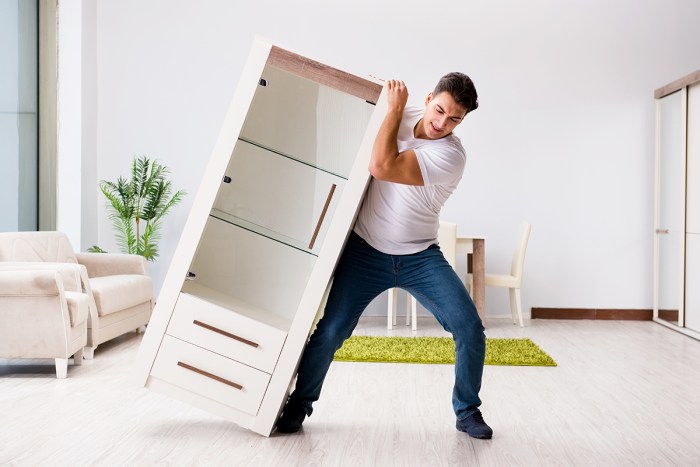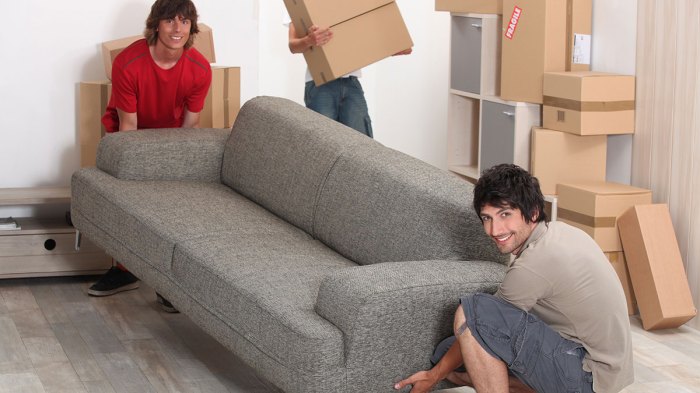Embark on a seamless furniture relocation journey with our comprehensive guide, ‘Move Furniture Help.’ This guide empowers you with expert tips and strategies to navigate every aspect of furniture moving, ensuring a stress-free and efficient experience.
Whether you’re tackling a DIY move or seeking professional assistance, our guide covers every scenario, providing invaluable insights and practical solutions to make your furniture relocation a breeze.
Moving Furniture Preparation
Planning and organizing are essential for a smooth furniture move. Decluttering and sorting items beforehand helps reduce the workload on moving day. Additionally, proper packing and protection measures safeguard furniture during transit.
Decluttering and Sorting
Decluttering before moving reduces the amount of items to be packed and transported. Sort items into three categories: keep, donate, and discard. Be ruthless and discard anything unnecessary or damaged.
Packing and Protection
Packing furniture correctly ensures its protection during transit. Use sturdy boxes and packing materials like bubble wrap, packing paper, and foam peanuts. Disassemble furniture when possible to minimize space and protect delicate parts. Wrap furniture legs and corners with cardboard or blankets for extra protection.
Hiring Professional Movers: Move Furniture Help

Professional movers offer convenience and expertise for relocation, but come with both advantages and drawbacks.Advantages:
-
-*Time and effort saving
Movers handle the heavy lifting, packing, and transportation, freeing up your time and energy.
-*Safety
Trained movers are equipped to handle bulky items and maneuver them safely, minimizing the risk of damage or injury.
-*Insurance coverage
Reputable moving companies provide insurance to protect your belongings during transit.
Disadvantages:
-
-*Cost
Professional moving services can be expensive, especially for long-distance moves or complex jobs.
-*Scheduling limitations
Movers’ availability may not always align with your preferred moving date.
If you’re looking for reliable and efficient assistance with your furniture moving needs, don’t hesitate to consider Rana Furniture . Their team of experienced professionals can expertly handle all aspects of furniture relocation, ensuring a seamless and stress-free experience. From planning to execution, Rana Furniture provides comprehensive move furniture help, tailored to your specific requirements.
-*Potential for delays or damages
Despite insurance coverage, there’s always a risk of delays or damage to your belongings.
Factors to Consider When Choosing a Moving Company
-
-*Reputation and experience
Check online reviews, industry certifications, and ask for referrals to find reputable movers.
-*Services offered
Determine the scope of services you need, such as packing, unpacking, furniture assembly, and specialty item handling.
-*Cost and availability
Get quotes from multiple companies and compare their rates and availability to fit your budget and timeline.
-*Insurance and licensing
Ensure the company is licensed and carries adequate insurance to cover your belongings.
-*Communication and professionalism
Look for movers who are responsive, courteous, and provide clear communication throughout the process.
Negotiating Costs and Ensuring a Smooth Move
-
-*Get multiple quotes
Contact several moving companies to compare their rates and services.
-*Negotiate based on volume
When it comes to moving furniture, having the right equipment and expertise can make all the difference. If you’re looking for professional assistance, consider Haverty Furniture . Their team of experienced movers can handle any size or type of move, ensuring your furniture arrives safely at its new destination.
Whether you’re moving a single piece or an entire household, they have the resources and know-how to make the process as seamless as possible.
The more belongings you have, the higher the cost. Consider decluttering or donating items to reduce the volume.
-*Request discounts
Ask about discounts for off-season moves, multiple services, or referrals.
-*Communicate clearly
Provide detailed information about your move, including the date, inventory, and any special requests.
-*Prepare your home
Clear pathways, pack non-essential items, and label boxes to expedite the loading process.
DIY Furniture Moving
Moving furniture without professional help can be a daunting task, but with careful planning and execution, it can be done safely and efficiently. Here’s a step-by-step guide to help you navigate the process:
Lifting and Carrying Heavy Items
- Assess the weight:Estimate the weight of the furniture to determine if it’s manageable to move on your own. If it’s too heavy, consider seeking assistance.
- Use proper lifting technique:Bend your knees and lift with your legs, keeping your back straight. Avoid twisting or bending while lifting.
- Carry close to your body:Keep the furniture as close to your body as possible for better balance and control.
Transporting Furniture
- Use dollies or sliders:If possible, use dollies or sliders to move heavy furniture to minimize strain and prevent damage to floors.
- Clear the path:Ensure the path is clear of obstacles and tripping hazards before moving furniture.
- Secure loose items:Remove or secure any loose items from the furniture to prevent them from falling out during transit.
Safety Precautions
- Wear appropriate footwear:Wear sturdy, closed-toe shoes with good ankle support.
- Avoid lifting alone:If the furniture is too heavy, don’t attempt to lift it alone. Ask for assistance from a friend or family member.
- Take breaks:If you feel tired or strained, take breaks to rest and avoid injury.
Common Mistakes to Avoid
- Overestimating your strength:Don’t attempt to move furniture that’s too heavy for you. It’s better to be safe than sorry.
- Lifting with improper technique:Using incorrect lifting techniques can strain your back or cause injury.
- Not securing loose items:Failing to secure loose items can lead to them falling out and causing damage or injury.
Furniture Disassembly and Reassembly

Disassembling furniture can be necessary for several reasons during a move. It may be required to fit large pieces through narrow doorways or hallways, or to reduce the overall weight of the furniture for easier transportation. Additionally, disassembling can help protect delicate or fragile parts from damage during the move.
Moving furniture can be a daunting task, but with the right help, it can be a breeze. Professional movers can make the process quick and easy, but it’s important to know how much to tip furniture delivery personnel to ensure they are fairly compensated for their services.
For more information on tipping etiquette, visit how much to tip furniture delivery . Remember, a little appreciation can go a long way in ensuring a smooth and successful move.
Before disassembling furniture, it’s crucial to carefully follow the manufacturer’s instructions, if available. If instructions are not available, proceed with caution and document each step with photos or videos for easy reassembly.
Tools and Safety
- Gather the necessary tools, such as screwdrivers, wrenches, and allen keys.
- Wear gloves and safety glasses to protect yourself from splinters or sharp edges.
- Work in a well-lit area with ample space.
Disassembly Steps
- Remove any detachable parts, such as cushions, shelves, or drawers.
- Identify and loosen all bolts, screws, or other fasteners.
- Carefully separate the components and lay them out in an organized manner.
Organizing and Labeling
- Use clear plastic bags or containers to store small parts, such as screws and bolts.
- Label each bag or container with the corresponding furniture piece and component.
- Take photos or videos of the disassembled furniture to aid in reassembly.
Reassembly Tips
- Refer to the manufacturer’s instructions or your documentation for guidance.
- Work on a stable and flat surface.
- Tighten all fasteners securely, but avoid overtightening.
Special Considerations
When moving, special considerations must be taken for fragile, heavy, or oversized furniture to ensure their safe transport. Delicate items require careful protection, while heavy and bulky pieces demand strategic maneuvering.
Fragile Furniture
- Wrap items in bubble wrap or packing paper for cushioning.
- Use sturdy boxes with ample padding to prevent breakage.
- Mark boxes clearly as “Fragile” and handle with care.
Heavy Furniture
- Disassemble heavy pieces whenever possible to reduce weight.
- Use furniture dollies or hand trucks for safe and efficient movement.
- Protect floors with moving blankets or cardboard.
Oversized Furniture
- Measure doorways and hallways to ensure the furniture can fit through.
- Consider removing doors or windows if necessary.
- Use lifting straps or get assistance to avoid strain or injury.
Furniture Placement and Arrangement
The art of furniture placement and arrangement is crucial in creating a space that is both functional and aesthetically pleasing. It involves understanding the principles of scale, balance, and flow to maximize the potential of your room.
Scalerefers to the size and proportion of furniture in relation to the room and other furnishings. Choosing pieces that are too large or too small can disrupt the harmony of the space. Balanceis about distributing the visual weight of furniture evenly throughout the room.
This can be achieved through symmetrical arrangements, where furniture is placed on both sides of a focal point, or asymmetrical arrangements, where furniture is grouped in different areas to create a sense of movement.
Flowrefers to the ease with which people can move around the room. Avoid blocking pathways or creating obstacles that make it difficult to navigate. Consider the traffic patterns in the room and arrange furniture accordingly.
Focal Points, Move furniture help
Identify the focal point of the room, such as a fireplace, large window, or piece of artwork. Arrange furniture to draw attention to the focal point and create a sense of purpose for the space.
Conversation Areas
Create comfortable seating arrangements that encourage conversation. Place chairs and sofas facing each other, with a coffee table or ottoman in between. Consider the distance between seating and ensure it’s close enough for easy conversation but not so close as to feel crowded.
Functionality
Prioritize functionality by placing furniture in a way that meets your needs. For example, position a desk near a window for natural light, or place a bookshelf within easy reach of your favorite reading spot.
Style
Consider the overall style of the room and choose furniture that complements the décor. For a traditional space, opt for classic pieces with ornate details, while a modern room may benefit from clean lines and geometric shapes.
Furniture Care and Maintenance
Furniture is an investment that can last for years to come with proper care and maintenance. By following these tips, you can extend the lifespan of your furniture and keep it looking its best.
The first step in caring for your furniture is to clean it regularly. The frequency with which you need to clean your furniture will depend on the material and finish. For example, leather furniture should be cleaned every few months, while wood furniture can be cleaned less frequently.
Cleaning Methods
There are a variety of different cleaning methods that you can use for furniture, depending on the material and finish. Here are a few of the most common methods:
- Vacuuming:Vacuuming is a great way to remove dust and dirt from furniture. Be sure to use a soft brush attachment to avoid damaging the fabric or finish.
- Wiping:You can wipe down furniture with a damp cloth to remove dust and dirt. Be sure to use a clean cloth and avoid using harsh chemicals.
- Polishing:Polishing furniture can help to protect the finish and give it a shine. There are a variety of different polishes available, so be sure to choose one that is appropriate for the material and finish of your furniture.
Preventing Damage
In addition to cleaning your furniture regularly, there are a few other things you can do to prevent damage. Here are a few tips:
- Avoid placing furniture in direct sunlight:Direct sunlight can damage the finish of furniture, so it’s best to avoid placing it in areas where it will be exposed to the sun for long periods of time.
- Use coasters:Coasters can help to protect furniture from spills and stains. Be sure to use coasters under all glasses, cups, and other items that could potentially damage the finish of your furniture.
- Be careful when moving furniture:When moving furniture, be sure to lift it properly and avoid dragging it across the floor. Dragging furniture can damage the finish and legs.
Restoring Furniture
If your furniture does become damaged, there are a few things you can do to restore it. Here are a few tips:
- Repair scratches:Scratches can be repaired using a variety of methods, depending on the severity of the scratch. For minor scratches, you can use a furniture touch-up pen or marker. For deeper scratches, you may need to sand the area and refinish it.
- Fix dents:Dents can be fixed using a variety of methods, depending on the size and location of the dent. For small dents, you can try using a suction cup or a plunger to pull the dent out. For larger dents, you may need to hire a professional to repair the damage.
- Reupholster furniture:If the upholstery on your furniture is damaged, you can reupholster it to give it a new look. Reupholstering furniture is a relatively expensive process, but it can be a great way to extend the life of your furniture and give it a new style.
Closing Summary

With ‘Move Furniture Help’ as your trusted companion, you’ll master the art of furniture moving, ensuring your prized possessions arrive at their new destination safely and stylishly. Embrace the joy of relocation with confidence, knowing that you’re equipped with the knowledge and strategies to make it a success.
FAQs
Can I move furniture on my own?
Yes, it’s possible to move furniture on your own, but it’s crucial to assess the size, weight, and fragility of the items and ensure you have the necessary tools and assistance.
How do I choose a reputable moving company?
Research potential movers, read reviews, compare quotes, and check for licensing and insurance to select a reliable and trustworthy company.
What are the best ways to protect furniture during a move?
Use protective materials like bubble wrap, blankets, and cardboard to safeguard furniture from scratches, dents, and damage during transit.